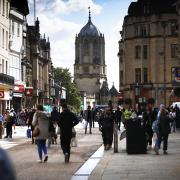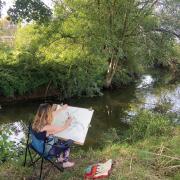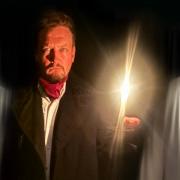Everyone knows there’s a lot of God in Gloucestershire, and in Oxfordshire too, but the flip side of that is that where God goes, so the Devil must follow to muck things up and entice folks down to hell. In everyday life, perhaps he’s good at that. In the stories – not so much!
Who is the Devil? We can find his image in churches up and down the Cotswolds, although there are far fewer images of him today than there were in the Middle Ages. In wall paintings at Oddington and in the west window at Fairford, we can see the Devil and his minions in all their glory at the Last Judgement. The images reminded congregations to live well by God’s laws so they could avoid the torments of hell. But such torture chambers are not the place of the Devil of folklore. He is out and about in the countryside. Wouldn’t you be, too, if the bedlam of hell awaited you at home?
In ancient times giants shaped the land across Britain. Have you heard how the giant Punlumon wept in his loneliness and his tears became the Severn, the Wye, and their sister the Ystwyth? You can follow the Severn Way all the way back to the river’s source – the giant now a mountain in North Wales. Or have you heard how the giants Vincent and Goram made the Avon and Henbury Gorges? As time went on, people started to forget about giants. But they lingered on in the west and often played dangerous games with the Devil as he took on their task of making the land.
Some landforms are an accident caused by the Devil getting in a grump. You may have heard how the Devil planned to dam the Severn and flood Gloucester because he felt the place had got too godly. But he got lost and tired wheeling along his heavy wheelbarrow of earth. When he met a quick-thinking cobbler who told him he’d worn out all the many shoes in his pack in walking this far from the Severn, the Devil dumped his load and so created Cam Peak near Uley.

Across Gloucestershire and Oxfordshire the Devil has given his name to various features. There’s the Devil’s Chapel at Bream in the Forest, the Devil’s Chimney at Leckhampton, two churchyards, a door at Miserden, his pulpit on Offa’s Dyke, a table to eat his dinner at on Crickley Hill, a couple of quoits, and the Devil’s flights, a field in the Duntisbournes, where he aggravates the Hoar Stone so much it runs round the field at midnight.
One quoit, also known as the Broad Stone, is the result of one of those games between Devil and giant. You see, the Devil was good mates, kind of, with the Herefordshire giant Jacky Kent. Jacky challenged the Devil to a throwing contest at Tidenham Chase, not far from the Severn. The Devil hefted up a big stone, more than nine feet long, to show off how strong he was. He made a mighty throw. A mile and a half his stone flew, landing near Stroat, almost in the Severn. Jackie praised the feat, but he had a gleam in his eye. This was a distance contest, after all, and so he selected a smaller stone. The Devil, to his fury, watched as it sailed right over the river and landed near the conveniently named village of Stone. Smarting with anger, he hiked off up the hill to Offa’s Dyke and made himself a stone pulpit so he could distract the monks attending mass in Tintern Abbey.
On one occasion it’s said the Devil did win. He met a beggar on Wytham Hill in Oxfordshire and the two of them made a bargain. If the beggar won a game of quoits, his soul was safe and he would go to heaven, but if the Devil won, the beggar would have to go to hell. They set to the throwing in earnest. The Devil created a circle of stone pegs down by Stanton Harcourt to catch the quoits, and then they stood on the hill and threw their huge loops. The beggar was good, but, sadly for him, the Devil was better. After dealing with the beggar’s soul, the Devil forgot about the stone circle he’d made. The locals took down the stones one by one to use them for bridges or to break them up for rubble. By the Middle Ages, only three large stones remained. By the 1940s, only one was left; it was buried and the site levelled to become an airstrip in the Second World War and, even worse, a gravel quarry in the 1970s. Between 2002 and 2008 the site was restored to how it may once have looked. All this hard work was done on a site right next to an active landfill. Perhaps the Devil continues to have the laugh there! As for the beggar’s soul, one version of the tale says that, as he was being dragged down to hell, some angels came and carried away to the other place. The Devil never gets the very last laugh.
He has continued to fret about the godliness of Gloucestershire. In one famous tale the Devil would sit on Leckhampton Hill of a Sunday and throw stones down on Cheltenham folk piously going to church. As Cheltenham got bigger, there were more and more people who wanted to pray, and the Devil threw more and more stones – until suddenly the hillside collapsed with him beneath it. With his incandescent anger the whole pile of rubble began to boil and bubble until the Devil shot out in a column of molten rock! The chimney stands to this day, and the Devil is said to still live underneath it.

He keeps a constant eye on Painswick, returning whenever a hundredth yew tree is planted or seeds itself. He pulls it up to keep the number a nice uneven 99. At Westbury-on-Severn he was offended by the church spire standing so tall and wrenched the whole tower free of the church to stand alone. The Devil can be contrarywise, though; it’s said that he built the three steeples of Adderbury, Bloxham, and King’s Sutton in one night! At both Minchinhampton and Checkendon there’s a spooky place called the Devil’s Churchyard, where the people of each place thought to build their church but were discouraged by the Devil tearing down their foundations each night. The locations were left to moulder, the taint of the Devil still said to be upon them. At Ambrosden the Devil would not only tear down the church but also move the materials to another spot. Day after day the villagers moved the stones back and rebuilt – until they finally gave in and built the church where the Devil wanted it!
Sometimes, like that cobbler, an individual gets one over on the Devil. There was a shepherd who had gone to the pub at Little Witcombe – not to drink, although he did have one or two – but to buy some medicine for his sheep, since the landlady was a dab hand in the still room. Heading home, he carried the medicine and a wee bit of ale to fortify him for the climb up to Birdlip. When he got to Dog Lane, he heard a growl and was instantly alert. Coming towards him down the hill was a shadowy figure. Were those horns he could see? Suddenly the shepherd was stone cold sober. With great presence of mind he tipped a little of the medicine into his ale. The figure approached, certainly the Devil, horned and hooved, and demanded a drink. ‘Spiced special for you, sir,’ quavered the shepherd, and handed over his flask. The Devil took a long draft. For a moment all was well. Then the medicine caught him a kick in the back of the throat. He let out a roar so loud you could hear him in Cheltenham. As for the shepherd – well, no one has ever run up that hill so fast!
ESSENTIALS
Places to visit: Oddington and Fairford churches for wall paintings and stained glass; Offa’s Dyke Path near Tintern; Stanton Harcourt; Leckhampton Hill; the churches at Westbury-on-Severn and Ambrosden; the lovely trio of steeples at Adderbury, Bloxham, and King’s Sutton.
Refreshments: There are many pubs near these locations, but for the full devilish experience how about the Five Alls in Filkins, where the sign reads, ‘“I plead for all” the lawyer; “I fight for all” the soldier; “I work for all” the yeoman; “I pray for all” the priest; and “I take all” says the Devil!’
Further reading: Gloucestershire Folk Tales by Anthony Nanson; Oxfordshire Folk Tales by Kevan Manwaring.
LINKS
Leckhampton Hill:.leckhamptonhill.org.uk
Devil’s Quoits, Stanton Harcourt:citydays.com/places/devils-quoits
Kirsty Hartsiotis is based in Stroud and available for hire as a storyteller and speaker. She is an accredited Arts Society lecturer. Her books include, among others, Wiltshire Folk Tales and (with Anthony Nanson) Gloucestershire Ghost Tales and Gloucestershire Folk Tales for Children. She is also a curator at Swindon Museums.



























